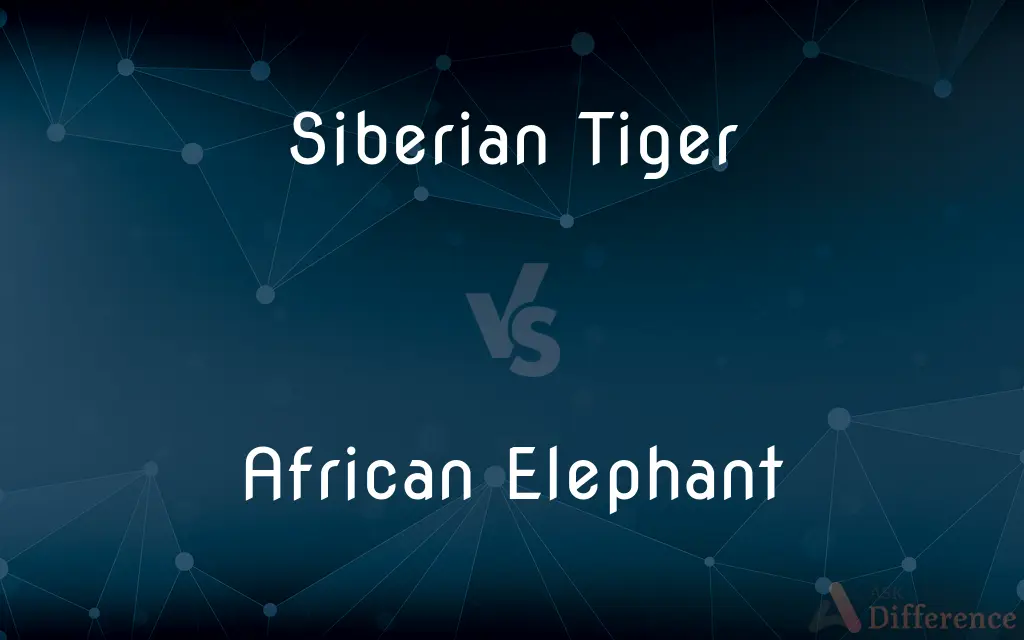Siberian Tiger vs. African Elephant — What's the Difference?
Edited by Tayyaba Rehman — By Fiza Rafique — Published on December 8, 2023
Siberian Tiger is a large feline predator from Asia. African Elephant is a massive herbivore mammal from Africa.

Difference Between Siberian Tiger and African Elephant
Table of Contents
ADVERTISEMENT
Key Differences
Siberian Tiger, also known as the Amur tiger, is the largest subspecies of tigers. Originating from the cold terrains of Siberia, they are adapted to live in harsh climates. African Elephant, on the other hand, is the world's largest land animal, originating from the vast terrains of Africa. Both are iconic species, symbolic of the beauty and diversity of the animal kingdom.
The Siberian Tiger, characterized by its thick fur and powerful build, is a carnivore that relies on hunting to survive. It has a deep orange coat with black stripes and can weigh up to 600 pounds. The African Elephant, distinguished by its enormous size and long trunk, is a herbivore that feeds mainly on grasses, fruits, and bark. With a weight that can exceed 13,000 pounds, it is an unmatched giant in the animal kingdom.
Habitats of the Siberian Tiger range from the cold deciduous and coniferous forests of eastern Russia to parts of China. Their solitary nature and territorial instincts are stark contrasts to the African Elephant's more social disposition, living in matriarchal family groups and roaming the grasslands, forests, and deserts of Africa.
Conservation is a concern for both the Siberian Tiger and the African Elephant. While the tiger faces threats from poaching and habitat loss, elephants also grapple with the menace of poaching, primarily for their ivory, and habitat encroachment. Both animals are keystone species, meaning their well-being is vital for the health of their respective ecosystems.
Interestingly, both the Siberian Tiger and the African Elephant are revered in their respective cultures. The tiger is often symbolized as a spirit of the forest and an indicator of the ecosystem's health in Asian cultures. The African Elephant, in contrast, is seen as a symbol of wisdom, strength, and royalty in many African cultures, playing a significant role in folklore and stories.
ADVERTISEMENT
Comparison Chart
Origin
Asia (Siberia)
Africa
Diet
Carnivore
Herbivore
Size & Weight
Up to 600 pounds
Up to 13,000 pounds
Habitat
Cold deciduous and coniferous forests
Grasslands, forests, and deserts
Conservation Status
Endangered
Vulnerable to endangered
Compare with Definitions
Siberian Tiger
The largest subspecies of tiger.
Researchers found the paw prints of a Siberian Tiger near the riverbank.
African Elephant
The largest terrestrial animal native to Africa.
The African Elephant towered over the other animals at the watering hole.
Siberian Tiger
An endangered species due to poaching and habitat loss.
Conservationists are working hard to protect the dwindling Siberian Tiger population.
African Elephant
A herbivorous mammal with long tusks and a trunk.
The African Elephant used its trunk to pluck leaves from the tree.
Siberian Tiger
A large carnivorous feline from Siberia.
The Siberian Tiger prowled silently in the snowy forest.
African Elephant
A symbol of wisdom and memory in various cultures.
In folklore, the African Elephant is revered for its unparalleled memory.
Siberian Tiger
An apex predator in Asia's cold forests.
A Siberian Tiger's roar echoed, asserting dominance in its territory.
African Elephant
A keystone species vital for ecosystem health.
The presence of the African Elephant ensures biodiversity in the savannah.
Siberian Tiger
A symbol of strength and power in many cultures.
Legends speak of the mighty Siberian Tiger guarding ancient treasures.
African Elephant
Targeted by poachers primarily for their ivory.
Conservationists are fighting to save the African Elephant from the threat of poaching.
Common Curiosities
What is a Siberian Tiger's primary diet?
Siberian Tigers are carnivores, primarily preying on deer and wild boar.
Why are African Elephants poached?
They are mainly poached for their ivory tusks, which are highly valued in illegal markets.
Are Siberian Tigers good swimmers?
Yes, Siberian Tigers are adept swimmers and often enter water to hunt or cool off.
Where can African Elephants be found in the wild?
African Elephants can be found in various habitats across Africa, including grasslands, forests, and deserts.
Is the Siberian Tiger the biggest of all tiger subspecies?
Yes, the Siberian Tiger is the largest subspecies of tiger.
What's the average lifespan of a Siberian Tiger in the wild?
Siberian Tigers can live up to 15-20 years in the wild.
Do African Elephants have predators?
While adults have few natural predators, lion prides and crocodiles can target young elephants.
How fast can a Siberian Tiger run?
A Siberian Tiger can reach speeds of up to 50-60 miles per hour in short bursts.
How many species of African Elephants are there?
There are two primary species: the African Forest Elephant and the African Bush Elephant.
What distinguishes an African Elephant from other elephant species?
African Elephants have larger ears and tusks compared to their Asian counterparts.
How do African Elephants communicate with each other?
African Elephants use a combination of vocal sounds, body language, and infrasound for communication.
How does the Siberian Tiger adapt to cold climates?
Siberian Tigers have thick fur and a layer of fat to insulate them from the cold.
How much water can an African Elephant drink in a day?
An African Elephant can drink up to 50 gallons of water a day.
Why are Siberian Tigers and African Elephants important for the ecosystem?
Both are keystone species, and their well-being directly impacts the health and diversity of their respective ecosystems.
How large is the territory of a Siberian Tiger?
A Siberian Tiger's territory can range from 500 to over 1,000 square kilometers, depending on resources.
Share Your Discovery

Previous Comparison
Absolute Dating vs. Relative Dating
Next Comparison
Constructive Criticism vs. Destructive CriticismAuthor Spotlight
Written by
Fiza RafiqueFiza Rafique is a skilled content writer at AskDifference.com, where she meticulously refines and enhances written pieces. Drawing from her vast editorial expertise, Fiza ensures clarity, accuracy, and precision in every article. Passionate about language, she continually seeks to elevate the quality of content for readers worldwide.
Edited by
Tayyaba RehmanTayyaba Rehman is a distinguished writer, currently serving as a primary contributor to askdifference.com. As a researcher in semantics and etymology, Tayyaba's passion for the complexity of languages and their distinctions has found a perfect home on the platform. Tayyaba delves into the intricacies of language, distinguishing between commonly confused words and phrases, thereby providing clarity for readers worldwide.














































